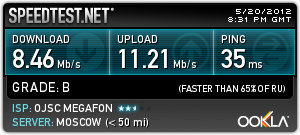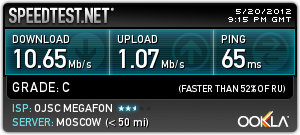4G LTE Internet Megaphone
May 15, 2012 Megafon began to provide mobile 4G Internet services using LTE technology : 4g.moscow.megafon.ru .
I asked Megafon to give me a modem for testing, and the very next day he ended up with me.

')
The modem is huge, jokingly I called it "Tsar Modem".

But unlike the Tsar Cannon, which does not shoot, and the Tsar Bell, which does not ring, the Tsar Modem works fine.
The modem works both in the new 4G network and in 3G and 2G networks, therefore, unlike the 4G Yota modem (I talked about it and the Yota LTE network: ammo1.livejournal.com/252365.html ), it also works there, where the 4G network is not. This is very relevant, given that the Moscow 4G network so far only works in Moscow and certain cities of the region (http://moscow.megafon.ru/help/coverage).

3G / 2G - Internet Megaphone provides with the help of its cellular network, and 4G with the help of the Yota network, however 4G Megaphone and Yota provide completely different things. Base stations are used the same, so the coverage area is the same, but the speed and quality of the Internet are different. This is because different channels of the Internet are used. The use of different frequencies on the same base stations was not confirmed.
The “Megaphone 4G” modem is sold in Megafon offices and online store at a price of 2990 rubles (http://moscow.shop.megafon.ru/modems_g__g_33_tree_992_1_61626.html).
At the same time, the absolutely unlimited 4G / 3G Internet is free until July 15, 2012.
From July 15, three tariffs will start to operate: 950, 1200 and 1500 rubles per month:

Let's go back to the modem. The modem is manufactured by Huawei and is called the E392.

A special sim card is installed in the modem, marked as “64K”.

I tried to install this sim card in another modem - 3G Internet worked fine. The reverse procedure was also successful: another Megafon sim card worked normally in this modem, only the 4G network did not appear. Simcard of another operator did not work - the program asked to install a SIM card Megaphone.
On the other side of the modem there are slots for a microSD memory card (card reader function) and two antenna connectors. Apparently, the modem has separate 4G and 3G / 2G radio paths and separate antennas can be connected to them.

When connected to a computer, the modem creates a virtual CD-ROM on which the installer of the Megaphone-modem program is placed (exactly the same as for conventional 3G modems). The modem driver is installed with this program.
Work modem in Linux is discussed here: habrahabr.ru/post/144239/#comment_4841134
I tested the modem speed of Megaphone 4G and compared its work with the work of the Yota modem. Testing was conducted at one in the morning, the modems were located in the same place - on the window of my seventeenth floor in Sviblovo. The signal level was 90%.
The best result of the Megaphone is 8.5 MB / s download, 11.2 MB / s upload.

The average result - 8 download, 14 upload, and the speed of both SpeedTest and internet.yandex.ru was quite stable and hardly changed from test to test.
Yota's best result was almost the same, but Download speed jumped from 3.5 to 9 from test to test.
The second test is downloading a 107MB file from a fast server. Testing was conducted at 22:00.
Megaphone - 128 seconds (833 kilobytes per second ~ 6.7 Mbit)
Yota - 410 seconds (260 kilobytes per second ~ 2 Mbit)
Compare Megaphone 4G and Yota on downloading torrents failed - it seems, Yota artificially limits the download speed of torrents: the speed fluctuated around a very low value of 40 kilobytes per second, while Megaphone had a speed of about 800 Kilobytes / sec.
I tried how 4G Internet works not at the window, but in the back of the room. At the same time, the signal power decreased from 90% to 30%.

As you can see, the download speed has remained high, and the upload speed has decreased significantly.
I turned off 4G and at the same time checked the speed at which 3G Internet Megafon works in my apartment. The maximum speed is 4.05 / 0.62, the average is 2.0 / 0.5.
Of course, I would very much like 4G Internet to work not only in Moscow and the nearest Moscow region. According to information from Megafon, until the end of 2012 it is planned to deploy a 4G network in the following cities of the Moscow region: Khimki, Balashikha, Podolsk, Korolev, Mytishchi (rts), Lyubertsy (rts), Elektrostal, Kolomna, Odintsovo (rts), Zheleznodorozhny, Serpukhov, Orekhovo -Zuevo, Krasnogorsk (RC), Sergiev Posad (RC), Schelkovo (RC), Pushkino (RC), Zhukovsky.
In conclusion, a few words about the prospects. In addition to using the Yota network, MegaFon owns 4G frequencies in Moscow, but will be able to provide services only after they sum up the results of tenders for federal frequency sets. In Moscow, MegaFon's own frequencies are TDD LTE, and Yota frequencies are FDD LTE. When MegaFon’s own LTE network is launched, MegaFon’s LTE subscribers will be able to use both TDD and FDD LTE, and after launching their own network, cooperation with Yota in Moscow will continue.
Undoubtedly, today the LTE offer from Megafon in Moscow is much more interesting than from Yota. At the same prices, the speed is higher and more stable, and the main thing is that 4G Internet is combined with 3G, which is almost everywhere, and even where there is no it, the good old GPRS works.
I asked Megafon to give me a modem for testing, and the very next day he ended up with me.

')
The modem is huge, jokingly I called it "Tsar Modem".

But unlike the Tsar Cannon, which does not shoot, and the Tsar Bell, which does not ring, the Tsar Modem works fine.
The modem works both in the new 4G network and in 3G and 2G networks, therefore, unlike the 4G Yota modem (I talked about it and the Yota LTE network: ammo1.livejournal.com/252365.html ), it also works there, where the 4G network is not. This is very relevant, given that the Moscow 4G network so far only works in Moscow and certain cities of the region (http://moscow.megafon.ru/help/coverage).

3G / 2G - Internet Megaphone provides with the help of its cellular network, and 4G with the help of the Yota network, however 4G Megaphone and Yota provide completely different things. Base stations are used the same, so the coverage area is the same, but the speed and quality of the Internet are different. This is because different channels of the Internet are used. The use of different frequencies on the same base stations was not confirmed.
The “Megaphone 4G” modem is sold in Megafon offices and online store at a price of 2990 rubles (http://moscow.shop.megafon.ru/modems_g__g_33_tree_992_1_61626.html).
At the same time, the absolutely unlimited 4G / 3G Internet is free until July 15, 2012.
From July 15, three tariffs will start to operate: 950, 1200 and 1500 rubles per month:

Let's go back to the modem. The modem is manufactured by Huawei and is called the E392.

A special sim card is installed in the modem, marked as “64K”.

I tried to install this sim card in another modem - 3G Internet worked fine. The reverse procedure was also successful: another Megafon sim card worked normally in this modem, only the 4G network did not appear. Simcard of another operator did not work - the program asked to install a SIM card Megaphone.
On the other side of the modem there are slots for a microSD memory card (card reader function) and two antenna connectors. Apparently, the modem has separate 4G and 3G / 2G radio paths and separate antennas can be connected to them.

When connected to a computer, the modem creates a virtual CD-ROM on which the installer of the Megaphone-modem program is placed (exactly the same as for conventional 3G modems). The modem driver is installed with this program.
Work modem in Linux is discussed here: habrahabr.ru/post/144239/#comment_4841134
I tested the modem speed of Megaphone 4G and compared its work with the work of the Yota modem. Testing was conducted at one in the morning, the modems were located in the same place - on the window of my seventeenth floor in Sviblovo. The signal level was 90%.
The best result of the Megaphone is 8.5 MB / s download, 11.2 MB / s upload.

The average result - 8 download, 14 upload, and the speed of both SpeedTest and internet.yandex.ru was quite stable and hardly changed from test to test.
Yota's best result was almost the same, but Download speed jumped from 3.5 to 9 from test to test.
The second test is downloading a 107MB file from a fast server. Testing was conducted at 22:00.
Megaphone - 128 seconds (833 kilobytes per second ~ 6.7 Mbit)
Yota - 410 seconds (260 kilobytes per second ~ 2 Mbit)
Compare Megaphone 4G and Yota on downloading torrents failed - it seems, Yota artificially limits the download speed of torrents: the speed fluctuated around a very low value of 40 kilobytes per second, while Megaphone had a speed of about 800 Kilobytes / sec.
I tried how 4G Internet works not at the window, but in the back of the room. At the same time, the signal power decreased from 90% to 30%.

As you can see, the download speed has remained high, and the upload speed has decreased significantly.
I turned off 4G and at the same time checked the speed at which 3G Internet Megafon works in my apartment. The maximum speed is 4.05 / 0.62, the average is 2.0 / 0.5.
Of course, I would very much like 4G Internet to work not only in Moscow and the nearest Moscow region. According to information from Megafon, until the end of 2012 it is planned to deploy a 4G network in the following cities of the Moscow region: Khimki, Balashikha, Podolsk, Korolev, Mytishchi (rts), Lyubertsy (rts), Elektrostal, Kolomna, Odintsovo (rts), Zheleznodorozhny, Serpukhov, Orekhovo -Zuevo, Krasnogorsk (RC), Sergiev Posad (RC), Schelkovo (RC), Pushkino (RC), Zhukovsky.
In conclusion, a few words about the prospects. In addition to using the Yota network, MegaFon owns 4G frequencies in Moscow, but will be able to provide services only after they sum up the results of tenders for federal frequency sets. In Moscow, MegaFon's own frequencies are TDD LTE, and Yota frequencies are FDD LTE. When MegaFon’s own LTE network is launched, MegaFon’s LTE subscribers will be able to use both TDD and FDD LTE, and after launching their own network, cooperation with Yota in Moscow will continue.
Undoubtedly, today the LTE offer from Megafon in Moscow is much more interesting than from Yota. At the same prices, the speed is higher and more stable, and the main thing is that 4G Internet is combined with 3G, which is almost everywhere, and even where there is no it, the good old GPRS works.
Source: https://habr.com/ru/post/144239/
All Articles